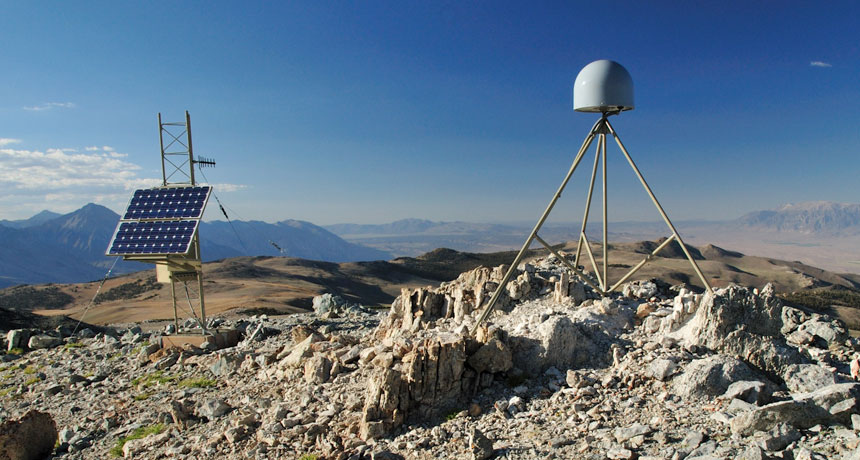Thirst for water moves and shakes California
In California’s Central Valley, removing groundwater to irrigate crops may trigger small earthquakes and uplift nearby mountains

This is a GPS station in the mountains of eastern California. Such stations can record tiny changes in altitude. Pumping groundwater from beneath the nearby Central Valley may be causing the mountains to rise, a new study finds.
UNAVCO
California’s thirst for water is creating unrest. During the dry season, tiny earthquakes rattle the state. And its mountains have begun creeping higher, bit by bit.
Scientists have just linked the two phenomena to the heavy pumping of water from natural reserves below California’s Central Valley. The groundwater provides drinking water and irrigates some of the country’s most productive farms.
Over the last 150 years, that pumping has removed 160 cubic kilometers (more than 38 cubic miles) of groundwater. That is more than fills Lake Tahoe. (This huge, deep lake straddles the California-Nevada state line.)
All that water has a lot of mass. The ground acts similar to a mattress after you get out of bed. So removing all that water weight from beneath the Central Valley has allowed the ground nearby to rise back up. In California, that upward movement has taken the surrounding mountains with it, scientists propose. It also may be triggering tiny quakes. Details appear in a study published May 14 in Nature.
This study is the first to connect the dots between pumping groundwater out of California’s Central Valley and changes to nearby peaks and quakes, says Kristy Tiampo. A geophysicist at the University of Western Ontario in London, Canada, she did not take part in the new research.
Tiampo says scientists used to have a different idea about why the mountains surrounding the Central Valley rise a bit more every year. They thought this uplift was tied to the movement of giant slabs of Earth’s crust, called tectonic plates. These plates cover the planet’s surface like pieces of a puzzle jammed together. Unlike puzzle pieces, they sometimes slide past each other.
“Everybody thought the uplift was due to tectonics — we thought it was all related to plate motion,” Tiampo told Science News. Two plates meet in California, and the boundary between them is called the San Andreas Fault. That fault runs north to south, right through the Central Valley.
Colin Amos had a different idea about what was triggering the mountains’ growth. He’s a geologist at Western Washington University in Bellingham. His team suspected both the mountain uplift and quakes were related to the enormous volumes of water being pumped from aquifers. These are natural underground pools. In California’s Central Valley, people are draining aquifers faster than nature can refill them.
Amos and his colleagues studied years of data from 566 GPS stations located along a swath of California, including the Central Valley. GPS stands for global positioning system. GPS relies on satellite signals to calculate the position of sensors, including their altitude. The stations record even tiny up-and-down movements of the ground.
In California, the GPS data showed that mountains near the San Andreas Fault rise between 1 and 3 millimeters (0.04 and 0.1 inch) every year. That’s about half the width of a paperclip. That measurement matched the researcher’s calculations for how much the Earth would shrug without the mass of the water in the region’s aquifers.
That match suggested groundwater removal might explain why the mountains rise, Amos told Science News. Still, he noted, “I was surprised.”
The upward movement doesn’t sound like much. Yet it could be just enough to unsettle the San Andreas Fault. As the ground expands upward, it pulls away from the fault. That unclamps the plates, making it easier for them to slide. That could explain the boost in little earthquakes seen in one location along the San Andreas during dry months.
Power Words
aquifer A layer of rock, sand or gravel that can contain or transmit groundwater.
earthquake A sudden and sometimes violent shaking of the ground, sometimes causing great destruction, as a result of movements within Earth’s crust or of volcanic action.
fault In geology, a fracture along which there is movement of part of Earth’s lithosphere.
geology The study of Earth’s physical structure and substance, its history and the processes that act on it. People who work in this field are known as geologists. Planetary geology is the science of studying the same things about other planets.
geophysics The study of matter and energy on Earth and how they interact.
global positioning system Best known by its acronym GPS, this system uses a device to calculate the position of individuals or things (in terms of latitude, longitude and elevation — or altitude) from any place on the ground or in the air. The device does this by comparing how long it takes signals from different satellites to reach it.
groundwater Water that is held underground in the soil or in pores and crevices in rock.
mass A number that shows how much an object resists speeding up and slowing down — basically a measure of how much matter that object is made from.
plate tectonics The study of massive moving pieces that make up Earth’s outer layer, which is called the lithosphere, and the processes that cause those rock masses to rise from inside Earth, travel along its surface, and sink back down.
tectonic plates The gigantic slabs — some spanning thousands of kilometers (or miles) across — that make up Earth’s outer layer.







